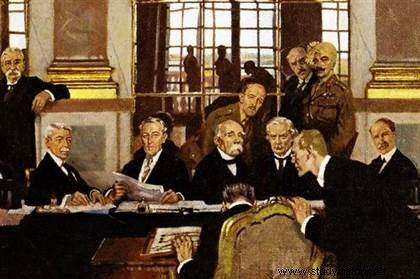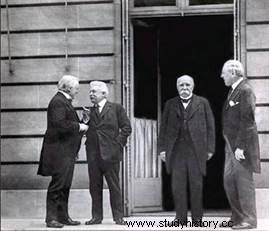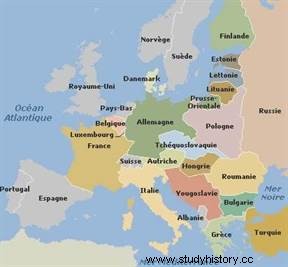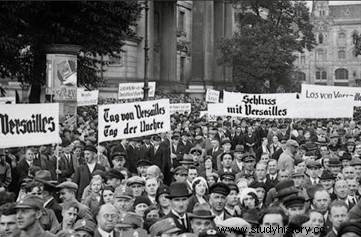 The Treaty of Versailles , signed on June 28, 1919 in the Hall of Mirrors of the Palace of Versailles between the Allies and Germany, ended the First World War. Because it settles a global, unprecedented and deadly conflict between several dozen countries on several continents, it is an essential moment in the history of the 20th century. Excluded from discussions, the defeated suffer heavy penalties. The Treaty of Versailles, which marks the humiliation of Germany and the rise of the United States of America, will trigger a new outbreak of nationalisms and will contribute to provoke a new world war twenty years later.
The Treaty of Versailles , signed on June 28, 1919 in the Hall of Mirrors of the Palace of Versailles between the Allies and Germany, ended the First World War. Because it settles a global, unprecedented and deadly conflict between several dozen countries on several continents, it is an essential moment in the history of the 20th century. Excluded from discussions, the defeated suffer heavy penalties. The Treaty of Versailles, which marks the humiliation of Germany and the rise of the United States of America, will trigger a new outbreak of nationalisms and will contribute to provoke a new world war twenty years later.
The Paris Peace Conference
At the Peace Conference which opened in Paris in January 1919, only the great victorious powers decided and declared the law. Wilson, Clemenceau, Lloyd George and Orlando will settle the destiny of Europe, of which very few still suspect the end of supremacy. They refer to the Fourteen Points that the American president formulated a year earlier. The essential principle of this program of world peace is the right of peoples to self-determination. But the partners have different conceptions of war and its settlement. Georges Clemenceau remarks that the American wish to reorganize Europe cannot be realized without taking into account historical constraints. The Old Continent is already turned upside down, centuries-old states have disappeared, others have been formed. Wilson, strong in American power, wanted to include in the peace treaties the pact of a League of Nations which must guarantee peace, international cooperation and the security of all its member states, equal in law.
 The negotiations between the Allies were quite difficult:Clemenceau, who wanted to ensure French hegemony in Europe by annexation of the left bank of the Rhine, control of the Ruhr and assurance of considerable reparations, clashed with England and the United States, anxious, for commercial reasons, to avoid the complete ruin of Germany; Japanese demands on German concessions in the Chinese province of Shan-tong provoked a conflict with China, whose delegation left the conference (May 1919); finally, contrary to the commitments made by the Treaty of London (April 26, 1915), the Allies, at Wilson's insistence, refused Italy the annexation of Fiume and Dalmatia, which led to the temporary departure of the delegation Italian (April/May 1919). However, on June 17, the Allies were able to transmit the final text of the treaty to the German government.
The negotiations between the Allies were quite difficult:Clemenceau, who wanted to ensure French hegemony in Europe by annexation of the left bank of the Rhine, control of the Ruhr and assurance of considerable reparations, clashed with England and the United States, anxious, for commercial reasons, to avoid the complete ruin of Germany; Japanese demands on German concessions in the Chinese province of Shan-tong provoked a conflict with China, whose delegation left the conference (May 1919); finally, contrary to the commitments made by the Treaty of London (April 26, 1915), the Allies, at Wilson's insistence, refused Italy the annexation of Fiume and Dalmatia, which led to the temporary departure of the delegation Italian (April/May 1919). However, on June 17, the Allies were able to transmit the final text of the treaty to the German government.
Territorial clauses of the Treaty of Versailles
The territorial clauses amputated one-eighth of Germany's territory and one-tenth of its 1914 population. To the west, Alsace-Lorraine was returned to France, Belgium received the small territories of Eupen and Malmédy, the Saar was placed under the control of the League of Nations for a period of fifteen years, at the end of which a plebiscite was to decide its fate, and France obtained ownership of the coalfield.
 To the east, German territory was cut in two; reconstituted Poland gained access to the Baltic Sea by annexing Poznan and West Prussia; East Prussia, cut off from Memel, found itself separated from the rest of Germany by the famous corridor of Dantzig (which became a free city). For Upper Silesia, a referendum would decide whether this province would become Polish or remain German. Germany lost all its colonies, whose League gave the mandate to France, England, the Union of South Africa and Japan.
To the east, German territory was cut in two; reconstituted Poland gained access to the Baltic Sea by annexing Poznan and West Prussia; East Prussia, cut off from Memel, found itself separated from the rest of Germany by the famous corridor of Dantzig (which became a free city). For Upper Silesia, a referendum would decide whether this province would become Polish or remain German. Germany lost all its colonies, whose League gave the mandate to France, England, the Union of South Africa and Japan.
The principle of nationalities quickly poses problems when it comes to changing borders:the peace treaties in 1919 which enshrine these territorial changes create other "minorities" dissatisfied. To the east, the creation of the Danzig “corridor” satisfied neither the Germans nor Poland, on which the Allies counted to fight Bolshevism. The Treaties of Saint-Germain (September 10, 1919) and Trianon (June 4, 1920) which ratified the dismantling of the Austro-Hungarian Empire were also sources of nationalist tension.
Military, economic and moral clauses
The military clauses included the dissolution of the general staff; the abolition of military service; the prohibition of heavy artillery, warplanes, tanks, submarines, battleships; the German ground forces were limited to 100,000 men, the naval forces to 16,000 men. The Allies were to occupy for fifteen years the left bank of the Rhine as well as the three bridgeheads of Mainz, Koblenz and Cologne; on the right bank was established a demilitarized zone 50 km deep.
Judged responsible for the conflict, Germany must pay compensation for the damage caused by the war. But the Allies had not been able to agree on the figure demanded and had only agreed that the amount of reparations would be fixed before May 1921; however, Germany had to pay, as a provision, 20 billion gold marks. German waterways (rivers and canals) were internationalized. Germany was to deliver a large part of the merchant fleet, machinery, railway equipment...
The moral clauses included Germany's acknowledgment of its responsibility for the war and the surrender of ex-Kaiser Wilhelm II and a number of his subjects held by the Allies for "war criminals".
Consequences of the Treaty of Versailles
 The treaty was received in Germany with violent hostility. For a few days, following an ultimatum from the Allies, the German general staff considered launching the country into desperate military resistance. Chancellor Scheidemann, after having campaigned against the signing of the treaty, resigned, but, finally, the Assembly of Weimar accepted the text (June 22, 1919), and, on June 28, 1919, the treaty was signed in the Hall of Mirrors of the Palace of Versailles.
The treaty was received in Germany with violent hostility. For a few days, following an ultimatum from the Allies, the German general staff considered launching the country into desperate military resistance. Chancellor Scheidemann, after having campaigned against the signing of the treaty, resigned, but, finally, the Assembly of Weimar accepted the text (June 22, 1919), and, on June 28, 1919, the treaty was signed in the Hall of Mirrors of the Palace of Versailles.
At the end of the First World War, defeated Germany was unable to meet the demands of the victors, notified in the 1919 Treaty of Versailles. "diktat" and "humiliating treaty", raises a wind of protest which serves the nationalist propaganda, in particular that of Adolf Hitler. The German parliamentary regime, held responsible for this national humiliation, must soon give way to an authoritarian regime.
The Treaty of Versailles was preceded by the Constituent Pact of the League of Nations. The creation of the League of Nations does not, however, give the new organization the necessary powers to enforce its decisions, since it does not have an international armed force. The Treaty of Versailles, which claimed to establish a lasting peace in Europe, was a complete failure. As soon as it was signed, it was attacked, in England and the United States, for its excessive harshness, and prepared a new outbreak of nationalism which was to lead, twenty years after its signing, to a new world war even more savage than the first.
To go further
- The Treaty of Versailles, by Jean-Jacques Becker. What do I know, 2019.
- The Treaty of Versailles and the End of the First World War:Chronicle of a Missed Peace, by Jonathan D'Haese. 50 Minutes, 2015.
- Versailles 1919 - Chronicle of a False Peace, by Patrick de Gmeline. City Press, 2009.
